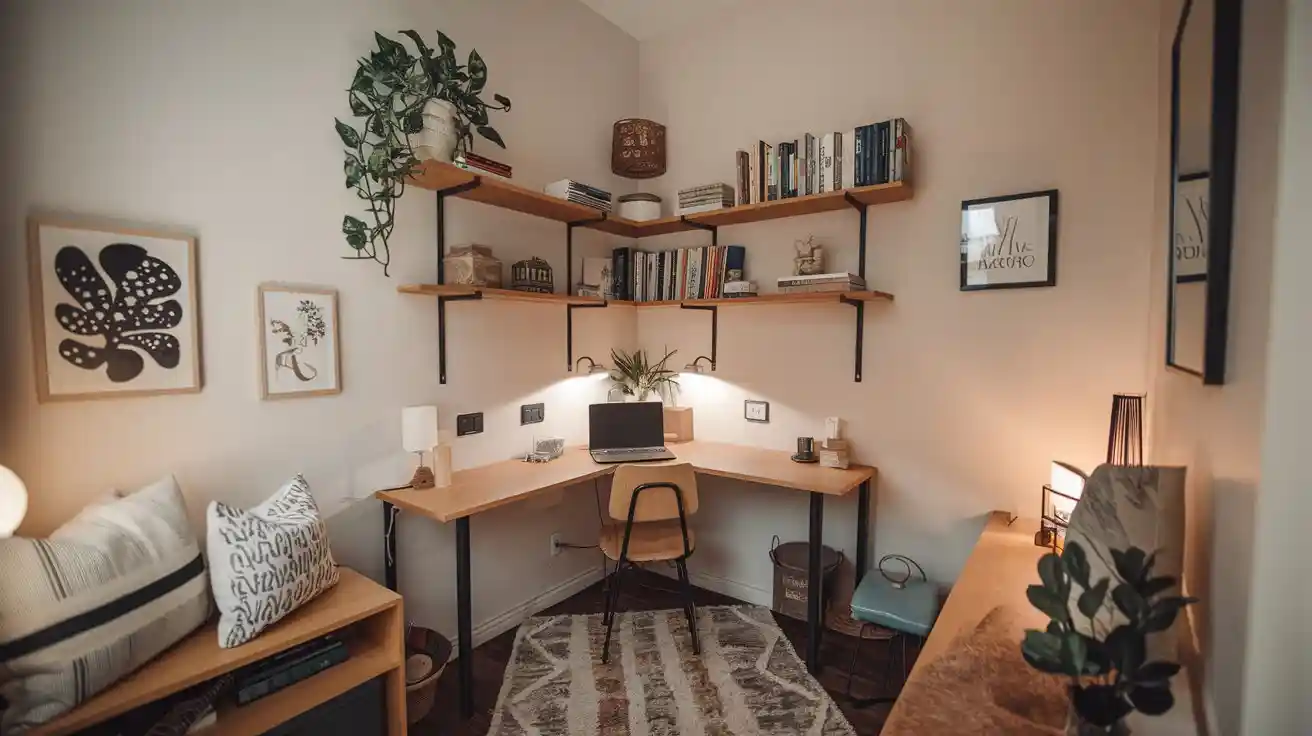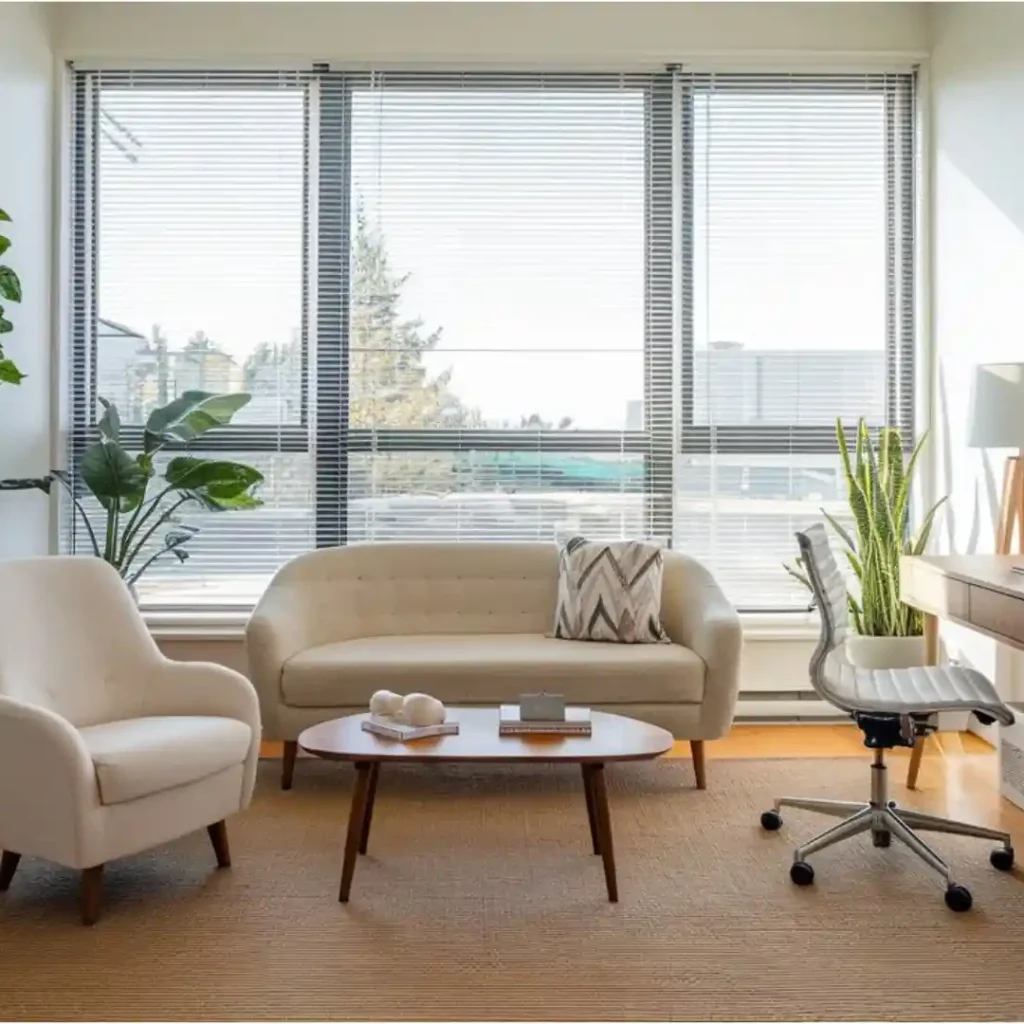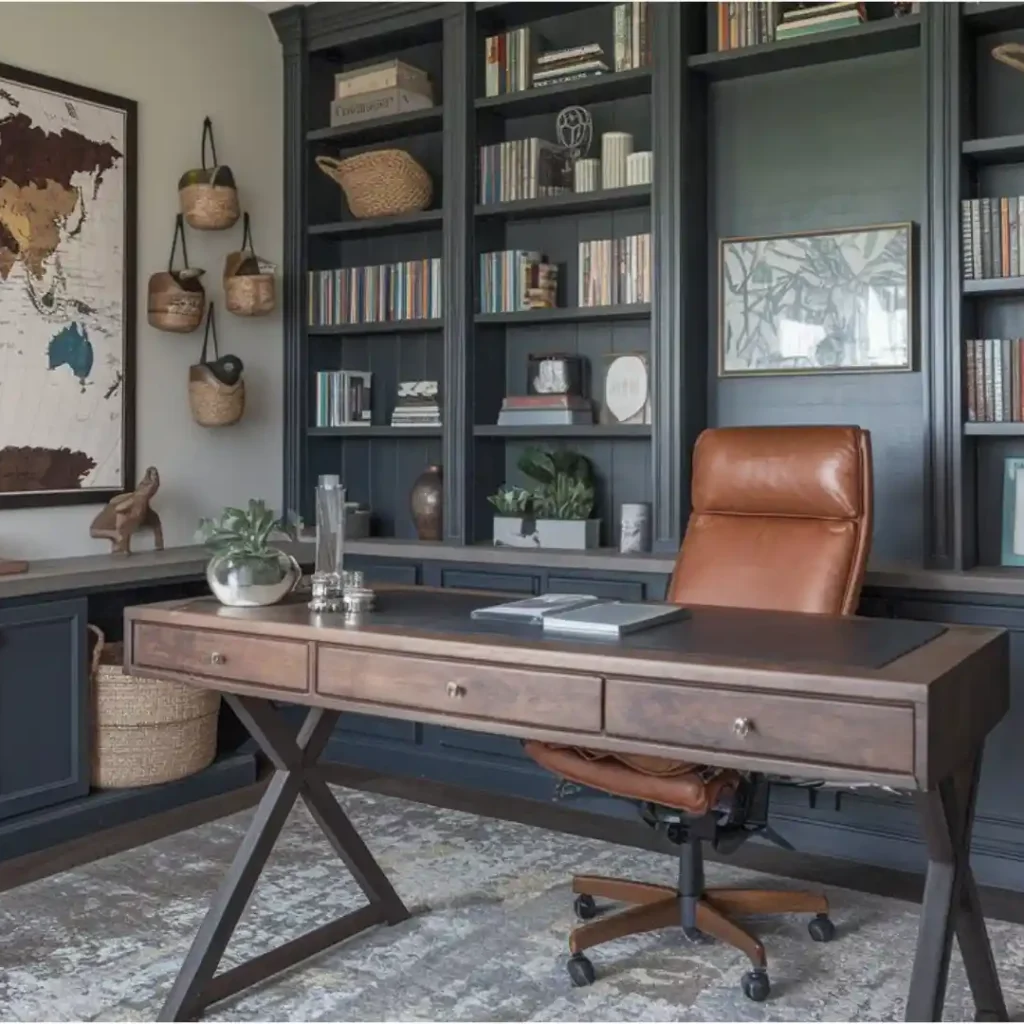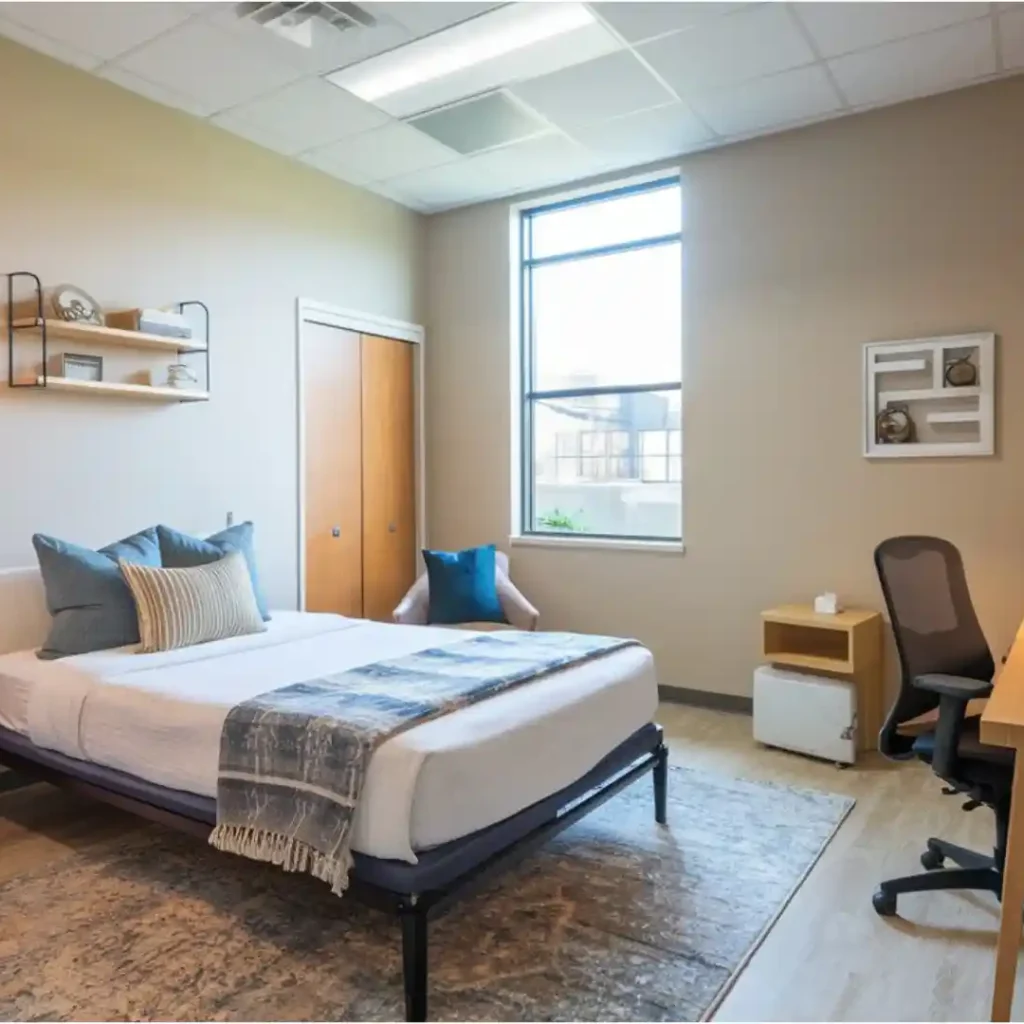Creating the perfect workspace starts with having the right home office layout ideas. A good home office layout can boost your productivity. It can inspire creativity and make working from home more enjoyable. This is true whether you work from home full-time or need a flexible space for personal projects. This article will share five modern home office layout ideas. They will help you create the perfect work environment.
Table of Contents
1. Minimalist Layout for Focus and Simplicity
Minimalism in design means using only the essentials. It eliminates excess and avoids clutter. In a minimalist home office, everything in the space should serve a purpose. This approach minimizes distractions. It allows for better focus and a calmer work environment. A minimalist office boosts productivity by promoting balance. It does this by keeping only what’s necessary.

Furniture Selection for Minimalist Design
Key Furniture:
- Compact Desk: The desk is central to any home office. In minimalist design, opt for a sleek, compact desk that fits the room without dominating it. The desk should be big enough to work. But, it must not be too big. This will keep the room open and airy. Desks with clean lines and simple shapes work best.
- Ergonomic Chair: Comfort is key, especially if you’re working for long hours. An ergonomic chair supports your posture. It helps reduce strain on your back, neck, and shoulders. In a minimalist design, choose a chair. It should be sleek, unobtrusive, and comfortable.
- Wall-Mounted Storage: Since minimalism relies on reducing clutter, storage is essential. Wall-mounted storage, like shelves or cabinets, saves floor space and keeps things organized. Wall-mounted options also keep the workspace feeling open and uncluttered.
Color Palette for Simplicity and Clean Aesthetic
Color Palette: A minimalist design uses neutral tones. They create a clean, calm, and sophisticated look.
- White: It is a base color. It creates an open, fresh feel. It makes the space seem larger and more organized.
- Gray: Soft shades of gray add a modern, sleek touch without overwhelming the space.
- Beige: Warmer tones like beige can soften the minimal look. They make the room feel more inviting while still being neutral. The goal is to create a peaceful, distraction-free work environment. It should use natural, calming colors.
Natural Light for Productivity and Mood
Natural Light: Maximizing natural light in a minimalist office space is crucial. Placing your desk near a window allows you to take full advantage of sunlight. Natural light brightens the workspace. It also boosts mental and physical health.
- It can improve your mood and focus, making you feel more energized throughout the day.
- It helps regulate your body’s natural rhythms. This can improve sleep and boost productivity. The light makes the room feel more open. It suits the minimalist design.
Organization Tips to Maintain Minimalism
Maintaining a minimalist office requires an organized approach. Here’s how to ensure the space stays clutter-free:
- Drawer Dividers: They keep small items organized and hidden, like stationery and chargers. By categorizing and storing them neatly, the workspace remains tidy.
- Cable Organizers: With modern technology comes the hassle of tangled cables. Use cable organizers to keep them hidden and prevent them from taking up visual space.
- Decluttering Techniques: Regularly declutter. Keep only the essentials on your desk. Regularly check your workspace. Remove anything not in use or add value. Drawer dividers and storage boxes keep papers and supplies organized.
2. Cozy Corner Office for Small Spaces
Not everyone has a large room to dedicate to a home office. For those with limited space, a cozy corner setup is one of the most practical home office layout ideas. A corner office can provide you with privacy.

Key Furniture
- Corner Desk: The main idea here is to utilize the corner of a room, which is often underused. The designers created a corner desk to fit into a room’s corner. It maximizes the floor area without taking up much space. It also has an efficient layout. It provides a place to set up your laptop and papers without cluttering the room. Corner desks can be compact. But, they still have enough space to work comfortably.
- Floating Shelves or Wall-Mounted Cabinets: To save floor space, use floating shelves or cabinets. They mount directly to the wall. They store office supplies, books, or decor. They do this without bulky, floor-standing furniture. They declutter the workspace. They keep everything organized and within reach. And they free up precious floor space.
Comfortable Seating
- Chair Selection: A comfortable chair is vital for productivity in a small workspace. In small spaces, find a chair that supports your back. It must also fit in the corner setup. Seek out supportive seats that enhance healthy posture. Also, choose sleek designs that don’t overwhelm the room.
- Additional Seating (Stool or Small Ottoman): If space allows, you can add a small stool or ottoman. This provides extra seating for visitors or for yourself when you need a break from the office chair. An ottoman with a liftable lid can also be used for storage. It can hold items like blankets, books, or office supplies.
Personal Touches
- Vertical Decorations (Art, Photos, Bulletin Board): The small workspace makes the walls perfect for adding some style. Hanging art, family photos, or a bulletin board can inspire you. They add your taste to the workspace without cluttering the desk. It also makes the office feel more like your own space, which can help improve mood and productivity.
- Plants and Decor: A few small plants can liven up a corner office. Greenery improves air quality. It adds nature, making the place inviting. A small clock, figurines, or a candle can make the space cozier and more personal. However, it’s important to keep the decor minimal to avoid making the area feel cramped.
Tip: Task Lamp & Laptop Stand
- Task Lamp: A small, focused task lamp is best for evening work or when more light is needed. Task lamps give focused light to a workspace. They save space and won’t overpower the room’s lighting. Look for slim, adjustable models. They should be flexible and not clutter the desk.
- Laptop Stand: A laptop stand raises the screen to eye level. It helps posture and reduces neck strain during long work sessions. It also frees up space beneath the laptop for storing papers or other small items. A stand can make the desk look more organized and professional. It helps create a clutter-free, productive environment.
3. Collaborative Workspace for Multiple Users
Creating a shared workspace for families or partners is key. It should promote teamwork while respecting users’ needs for space, order, and comfort. This home office layout ideas suits people who share a space but have different tasks. It ensures each can work efficiently without feeling cramped or distracted.

Key Furniture for Collaboration
- Long Shared Desk or Two Side-by-Side Desks: A crucial element of a collaborative workspace is the desk setup. A long shared desk can fit many users. It keeps the room open and connected. Alternatively, you can use two side-by-side desks. They allow for some individual space while still fostering collaboration.
- Adequate Surface Area: Each user should have space for their work essentials, like laptops and notebooks. Make the surface area large enough to separate personal and work items. This will help maintain productivity.
- Separate Storage Solutions: To avoid clutter, provide separate storage for each person. Rolling cabinets or mobile drawers are practical. They let users store personal items nearby and move them if needed. This helps maintain order and ensures everyone has access to their own supplies.
Separation of Space
- Dividers, shelving units, or plants: It’s a shared workspace, but some separation can help people focus on their tasks. Dividers or shelves can subtly separate the two workspaces. They give each person privacy without complete isolation.
- Natural Dividers: Use plants as dividers to keep an open, airy feel. Plants can create a sense of separation without making the space feel small or enclosed. They also enhance the room’s look, adding a calming, refreshing touch.
Tech Setup for Multiple Users
- Individual Power Outlets and Charging Stations: Each person should have easy access to their power outlets and charging stations. This will prevent the hassle of sharing or swapping cords. This setup lets both users work uninterrupted. It’s vital in a modern workspace with many devices in use.
- Monitors: If both users need screens, each must have a monitor. This avoids issues with screen sharing. This will improve focus and workflow efficiency.
- Noise-Canceling Headphones: If both users take calls often, noise-canceling headphones can be a game changer. They help with focus. This way, each person can stay focused on their tasks. The others’ conversations or activities won’t distract them.
Encouraging Collaboration
- Shared Whiteboards or Pinboards: It’s important to keep personal workspaces. But, a shared area for brainstorming can boost productivity. Use whiteboards or pinboards to track tasks, visualize ideas, or make quick notes.
- Digital Planning Tools: Tech-savvy users can try apps like Trello, Asana, or Google Keep. They keep both parties aligned on tasks and deadlines, improving collaboration and communication.
Personalization
- Consistent Color Palette: Use a cohesive color scheme to unify the workspace. This unifies the visual identity, rendering the space aesthetically pleasing.
- Individual Touches: Allow everyone to personalize their workspace with items like photos, small plants, or favorite accessories. This helps each user feel a sense of ownership and comfort while working.
4. Multi-Functional Office and Guest Room
In small homes, a multi-functional home office layout can be a game changer. An office that doubles as a guest room lets you optimize your space. You won’t sacrifice functionality.

Key Furniture
- Sleeper sofas and daybeds: These types of furniture are ideal for maximizing space in small homes. They save space. A sleeper sofa is a couch that can be transformed into a bed for guests. It provides seating during the day and becomes a comfortable sleeping area at night. Daybeds serve a similar purpose—they can be used as a sofa and are easily adaptable as a bed. Both options let you use your home office for work. They also let you turn it into a guest room when needed.
- Foldable or Wall-Mounted Desk: Space-saving desks are essential in a multi-functional room. A foldable desk can be collapsed when it’s not in use, freeing up floor space for your guest. A wall-mounted desk is another great solution. It takes up little space and can often be folded flat against the wall when not needed. Both types of desks provide a sleek and modern look without sacrificing functionality.
Smart Storage
- Multifunctional Furniture: Ottomans with hidden storage and desks in bookshelves serve dual purposes. An ottoman can be a footrest or extra seat. It can store office supplies or guest items, like blankets. Bookshelves with built-in desks save space. They offer storage for books and decor. They also provide extra workspace when needed. These furniture options are excellent for keeping the space organized while minimizing clutter.
- Wall-Mounted Cabinets: They are great for keeping your office tidy and freeing up floor space. They can store office supplies or guest items (like extra bedding) discreetly. Hiding these essentials keeps the room uncluttered. It creates a calm, efficient workspace that can quickly become a welcoming guest room.
Balancing Both Functions
- Guest Comfort: To welcome guests, add cozy textiles. Use cushions, throws, and soft bedding. These touches will make the sleeper sofa or daybed more comfy for overnight stays. They’ll also give the room a homely feel.
- Professional Look for Office: The room must also work as a workspace. This can be done by keeping the design neutral and professional. Use a neutral color palette—soft grays, whites, or beiges. It should blend the office and guest room functions. This keeps the room from feeling too personal or informal. That’s essential for productivity.
Quick Tips for Keeping the Space Functional
- Clutter-Free Guest Area: Keep a clean, organized space when the office is in use. Stylish bins or baskets offer a quick and simple way to keep things tidy. If guests leave belongings, you can store them in these bins. This will keep the space clutter-free while you work. These also come in handy when you need to tidy up your office supplies quickly before guests arrive.
5. Tech-Savvy Office for Digital Professionals
For those who rely heavily on technology, a tech-savvy home office layout is one of the most critical home office layout ideas. This layout suits digital pros, gamers, and creators. They need multiple monitors, fast internet, and a smooth workflow.

Key Furniture:
- Spacious Desk: Digital pros often need multiple monitors and a laptop. So, a spacious desk is essential for their gadgets. A large surface area allows for better organization. It helps manage a multi-screen setup, accessories, and work documents without clutter. Look for desks with cable management systems to avoid cord chaos.
- High-Quality Office Chair: Comfort is crucial when working long hours at a desk. A good office chair is key. It must have an adjustable height, lumbar support, and breathable fabric. This will ensure good posture and reduce strain. Ergonomic chairs are great for digital workers who sit all day.
- Sturdy Storage for Tech Accessories: Use nearby drawers or shelves to organize your workspace. You need places to store items like cables, cameras, and hard drives. A well-organized setup saves time and prevents frustration when looking for essential tools.
Cable Management:
- Cable Trays or Clips: With multiple devices, there will be a lot of cords. Using cable trays or clips helps keep these cords organized and out of sight. It improves your workspace’s look. It also reduces tripping hazards and makes cleaning easier.
- Docking Station: A docking station combines your tech devices. It makes it easier to connect and disconnect them. This cuts the need for multiple cables across the desk. It helps streamline your workspace. It’s especially useful for professionals who frequently switch between devices.
Lighting:
- Smart Lighting Solutions: In a tech-savvy office, lighting is vital. It must reduce eye strain, not just provide visibility. Smart lighting setups enable you to manage brightness and color temperature. You can even schedule lighting changes throughout the day. This can reduce glare on monitors. It will make long screen work more comfortable.
- Modern, Futuristic Ambiance: Smart lighting can enhance the room’s look. It creates a modern, tech-forward vibe. LED strips or color-adjustable floor lamps can give the room a sleek, futuristic vibe. They also provide practical lighting.
Tech Accessories:
- Noise-Canceling Headphones: For pros who need to focus or attend meetings, these headphones block out background noise. They improve concentration and communication. They are especially useful in shared spaces or homes with background noise.
- High-Quality Microphone: A good mic is essential for content creators, gamers, and professionals who attend virtual meetings or record content. A high-quality microphone ensures clear, professional-sounding audio. This is vital for podcasts, video calls, and streaming.
- Fast, Reliable Wi-Fi: Tech-savvy professionals need a strong, stable internet connection. Fast Wi-Fi allows smooth video calls, file transfers, gaming, and uploads. There will be no interruptions. A good router or mesh network can eliminate dead zones. It will ensure a strong, consistent connection.
Tip: Add a Sit-Stand Desk Option:
- Ergonomic Health and Flexibility: Long sitting can cause back pain and health issues. A sit-stand desk gives you the option to change between sitting and standing. This helps improve posture, reduce fatigue, and promote better circulation. Sit-stand desks help tech professionals who work long hours on screens. They need a way to stay active during work.

Final Thoughts on Modern Home Office Layout Ideas
When choosing the right home office layout ideas, it’s essential to consider your specific needs, available space, and personal style. Whether you’re drawn to the sleek lines of minimalism, the cozy warmth of a small corner office, or the advanced tech setup of a digital workspace, these ideas will help elevate your home office experience. A thoughtfully designed workspace can boost your productivity, enhance creativity, and make working from home a seamless part of your daily routine.
FAQs
1. What are the best home office layout ideas for small spaces?
For small spaces, a cozy corner office layout works best. Use a corner desk and vertical storage to save space. Try floating shelves or wall-mounted cabinets. A clutter-free, organized space is key to a functional workspace in a small room.
2. How can I create a minimalist home office layout?
To create a minimalist home office layout, focus on simplicity and functionality. Use a sleek, compact desk, a comfortable ergonomic chair, and minimal decor. Use neutral colors. Cut clutter with smart storage, like drawer organizers and cable management systems.
3. What is the ideal layout for a shared home office?
For shared spaces, a collaborative workspace layout works best. You can opt for a long desk or side-by-side desks, ensuring each person has enough space. Use personal storage, like rolling cabinets and shelving units. They help keep the shared area private and organized.
4. How can I design a home office that doubles as a guest room?
A multi-functional home office and guest room layout is great for optimizing space. Add a sleeper sofa or daybed for guests. Use foldable or wall-mounted desks to save space. Choose decor that is neutral and welcoming for both office use and guest accommodations
5. What are the key features of a tech-savvy home office layout?
A tech-savvy home office needs a spacious desk. It must hold multiple monitors, have fast internet, and manage cables well. Invest in noise-canceling headphones, smart lighting, and ergonomic furniture. They will create a productive and comfortable workspace.
6. How can I increase productivity with my home office layout?
Maximize productivity by designing your home office to suit your working style. Prioritize natural light. Use ergonomic furniture. Keep the workspace organized with storage. A layout that suits your workflow and cuts distractions can boost focus and efficiency.
7. What is the best lighting for a home office?
Natural light is ideal for a home office, as it boosts mood and productivity. If there’s no natural light, use adjustable task lighting. It reduces eye strain. For tech-heavy setups, smart lighting is a great choice. It minimizes glare on screens.
8. How can I add personal touches to my home office layout?
Add personal touches. Use artwork, plants, or decor that reflects your style. In minimalist or shared offices, subtle decor can help. Framed photos, motivational quotes, and color-coordinated supplies can personalize the space
9. What is the best furniture for a modern home office?
The best furniture for a modern home office is a sleek, ergonomic desk and chair; functional storage, like wall-mounted shelves or rolling cabinets; and any tech accessories you need, like monitor stands or docking stations.
10. How do I manage cables and cords in a home office layout?
Effective cable management is key to a tidy workspace. Use cable trays, clips, or sleeves to keep cords organized and hidden. Consider a wireless keyboard and mouse, or a docking station. They will reduce the visible cables on your desk.




Pingback: Innovative 2025 Home Office Trends to Boost Your Workflow - Style Bliss Home
Pingback: How To Design a Home Gym and Office That Energizes You - Style Bliss Home
Pingback: 10 Home Office Paint Colors Ideas That Ignite Creativity - Style Bliss Home
Pingback: Stunning Kitchen Island with Dining Table Designs - Style Bliss Home
Pingback: 13 Small Office Bathroom Ideas That Make a Big Impact - Style Bliss Home
Pingback: Seductive Dark Romantic Bedroom Designs to Captivate You - Style Bliss Home
Pingback: Stylish Outdoor Covered Kitchen Ideas for Dream Backyard - Style Bliss Home
Pingback: Top 2025 Dining Room Trends You’ll Want to Steal! - Style Bliss Home